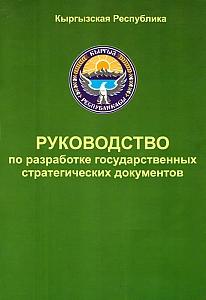GUIDELINES FOR THE DEVELOPMENT OF THE STATE STRATEGIC DOCUMENTS

The Administration of the President of the Kyrgyz Republic
World Bank project “Institutional Support to PRSP-2”
Public Association “Promotion and Development Center”
GUIDELINES FOR THE DEVELOPMENT OF THE STATE STRATEGIC DOCUMENTS
The methodological basis for the development of strategic documents. The experience of many developed countries shows that the introduction of common tools and methodological framework for strategic planning greatly increases the quality of the entire system of public administration.
Content:
INTRODUCTION
SUMMARY OF THE MANUAL
I. STAGES OF STRATEGY DEVELOPMENT
A. Stage1: Background and organization of work
1. Objective: The rationale for the strategy
2. Objective: Issue identification and structuring
3. Objective: Project planning for strategy development
4. Objective: Building a team
5. Result: The project proposal and plan
6. Aspects of management
7. Critical issues of the first stage
B. Stage 2: Research and Analysis
1. Objective: Data Collection
2. Objective: Information analysis
3. Objective: Capacity analysis
4. Result: An interim analytical report on the description of the current situation
5. Aspects of management
6. Critical Issues of the second stage
C. Step 3. Determination of the strategic direction
1. Objective: Determination of the guideline
2. Objective: Description of the vision
3. Objective: Determination of the strategic objective and sub-goals
4. Result: The preferred strategic direction
5. Aspects of management
6. Critical issues
D. Step 4. Policy development and implementation of the design process
1. Objective: The development of alternative policies
2. Objective: Detailed policy options
3. Objective: Evaluation of policy options
4. Objective: Planning for implementation
5. Result: The final report and implementation plan
6. Aspects of control
7. Critical Issues stage
II. SKILLS AND TOOLS FOR STRATEGY DEVELOPMENT
A. People and project management
1. Building a team
2. Strengthening the team
3. Teamwork
4. Stimulation of creativity
5. Receiving and giving feedback
6. Project plan development
7. Structuring the work
8. Definition of the intermediate results
9. Risk management
10. Definition of accountability
11. Project evaluation
D. Stage 4. Policy development and implementation of the design process
1. Objective: The development of alternative policies
2. Objective: Detailed policy options
3. Objective: Evaluation of policy options
4. Objective: Planning for implementation
5. Result: The final report and implementation plan
6. Aspects of control
7. Critical Issues stage
II. SKILLS AND TOOLS FOR STRATEGY DEVELOPMENT
A. People and project management
1. Building a team
2. Strengthening the team
3. Teamwork
4. Stimulation of creativity
5. Receiving and giving feedback
6. Project plan development
7. Structuring the work
8. Definition of the intermediate results
9. Risk management
10. Definition of accountability
11. Project evaluation
B. Stakeholders management and information support
1. Identification of the key stakeholders and issues of their concern
2. Effective engagement with stakeholders
3. Stakeholder involvement plan
4. Six criteria for effective consultation
5. The Plan Information Management
6. Contacts with the mass media
7. Evaluation of communication
8. Preparation of presentations
C. Structuring thinking
1. The problem tree
2. Thinking on the basis of basic principles
3. System thinking
4. Analysis of strengths, weaknesses, opportunities and threats (SWOT analysis)
5. Pest Analysis
6. The methods of creativity stimulation
D. Building the base of evidence/ fact gathering
1. Data Collection-Types and data sources
2. Data collection-surveys
3. Data collection-interviews and focus groups
4. Data analysis-Simulation
5. Data analysis-market analysis
6. Data analysis-an organizational analysis
7. Lessons from other-comparison to international experience
8. The lessons of others-benchmarking
9. Look in the future-forecasting
10. Look in the future-development of the scenarios
11. Look to the future-analysis of the reciprocal
E. Evaluation of alternatives
1. Multi-criteria analysis
2. Cost-benefit analysis, cost-effectiveness analysis
3. Advisability of the government intervention
F. Planning of the strategy implication
1. Shift management
2. Institutional shift
3. Strategy implication plan
4. Program-based budget
Annex 1. Budget Circular for Budgeting the year of 2008
